A Healthy dog is a happy dog
Before I begin, please understand that this is not meant to be a stand-alone resource on health for anyone buying a SWHD (or any other Dachshund) but rather a brief introduction and overview of some of the health considerations for the breed. Also, that much of the information here is taken from the resource Dachshund Health UK and I would like to extend my thanks for all the effort they put into their website and promoting the health of the Dachshund.

Please also consider that my focus here is on the STANDARD WIRE HAIRED DACHSHUND, because that’s who we have here at Bramalodge. Some of the information is very definitely relevant to all the breeds of dachshund, but as we have less health concerns with our variety and (currently) no compulsory health testing (although this may change soon) I haven’t covered everything for all.
Dachshund Health UK is definitely the No.1 place to start if you want more detail on our variety, or any of the others.
All dogs can suffer from health problems from time to time. Some individuals more than others and some breeds more than others. Overall, the WHD is a healthy breed with few health concerns. It is a category 2 breed in The UK Kennel Clubs ‘Breed watch’ initiative – where currently; weight, excessive tearing of the eyes and correct hind limb conformation and action are points of concern, that judges in the show ring should be vigilant on.
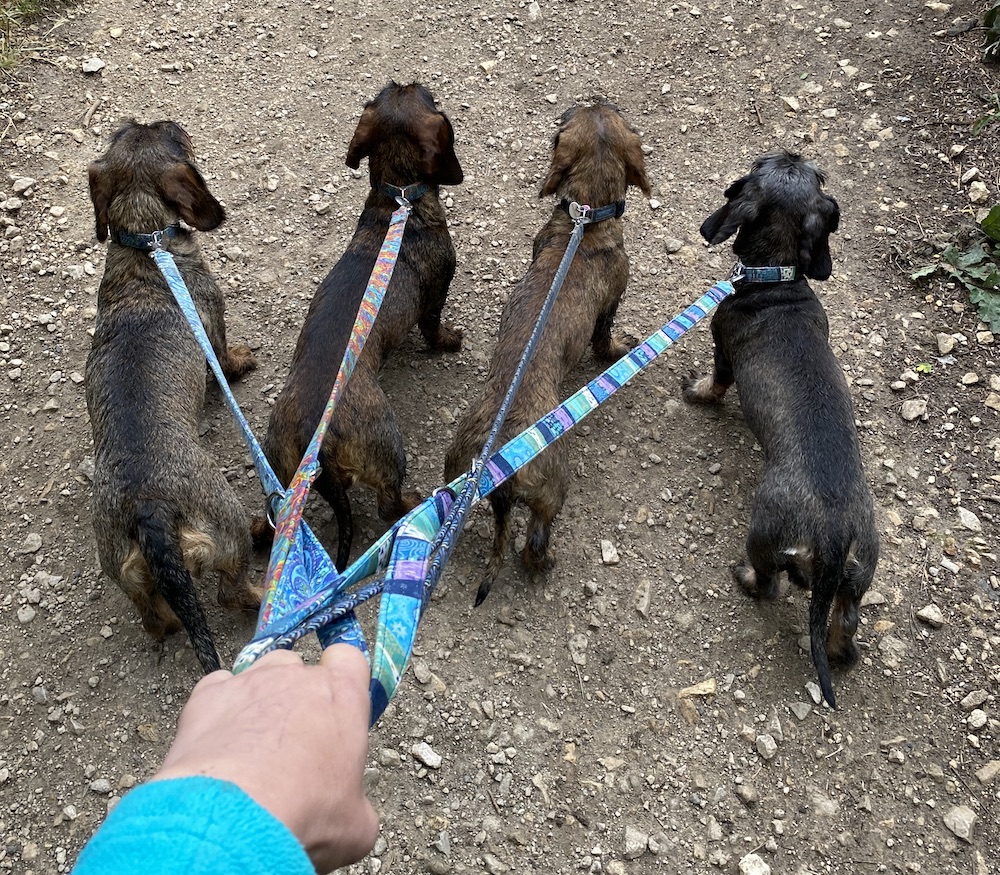
There are, however, many other things that judges should be looking for in a sound and healthy WHD! The breed standard is a very useful guide to what the correct conformation and movement of a dachshund should be.
But is any of that relevant to you if you don’t want to show?
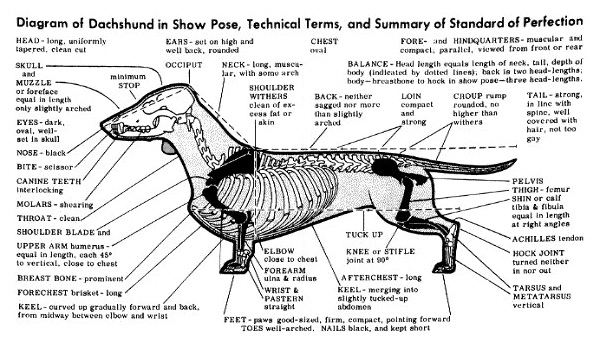
In short (along with many other contributing factors) Conformation (how a dog is physically put together) is fundamental to soundness of movement and in turn, health…the longevity of that soundness/the animal.
Dachshund Health UK say:
Breeders should be selecting away from exaggerations in length of back and shortness of leg and avoid breeding from dogs with a history of back problems.
Exhibitors and judges should note the evidence that longer dogs are more prone to back disease and remind themselves that our Breed Standard calls for a moderately long dog, with good ground clearance.
Puppy buyers should aim to buy from litters where the parents have more moderate conformation; i.e. shorter backs and longer legs AND no family history of back disease.
But there is more to a healthy dachshund than what it looks like… so….
Intervertebral Disc Disease (IVDD)
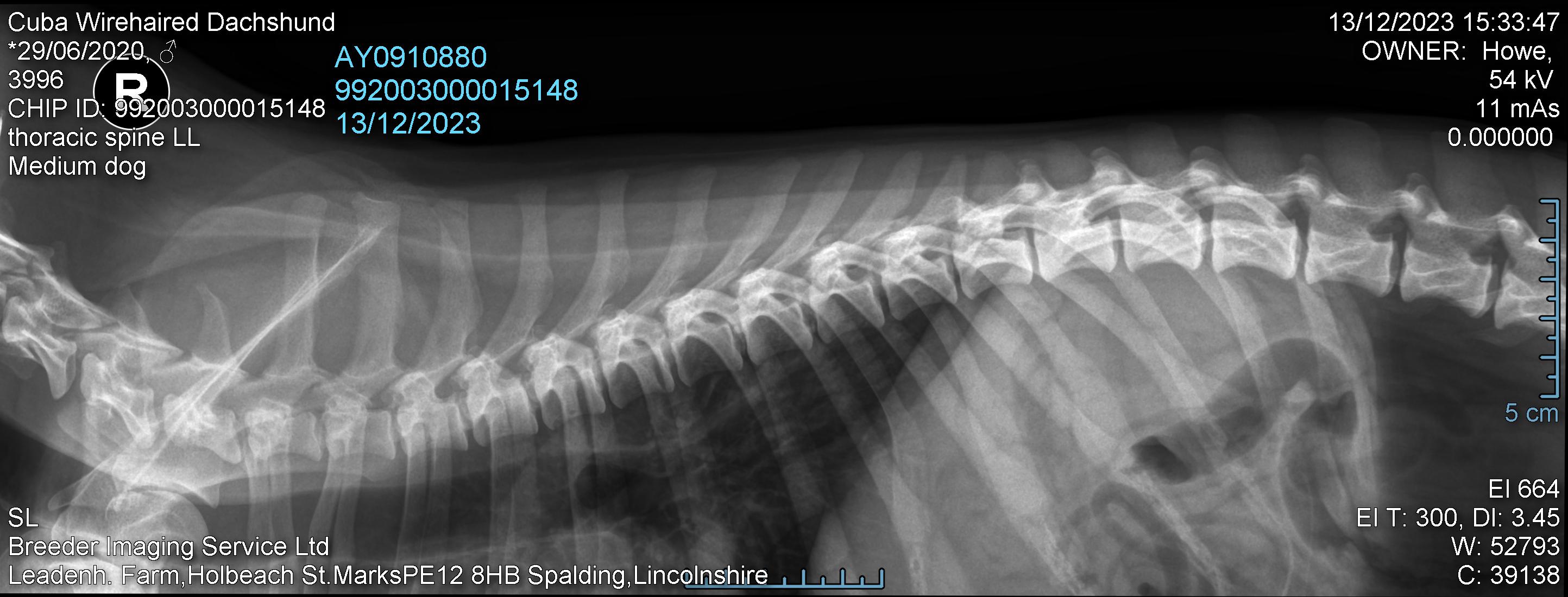
In Summary from IVDD Dachshund Health UK:
The fact that Dachshunds are a short-legged breed remains the biggest causal factor in IVDD because the discs in the spine calcify at a much younger age than in normal-legged breeds of dog. Additionally, IVDD has a strong heritability, meaning it runs in families. Dogs whose parents and other ancestors suffered from IVDD are much more likely also to suffer from IVDD. Unfortunately, just because your dog is fit and in good body condition does not guarantee that it will avoid back problems.
Nevertheless, prevention is better than cure, so lifestyle choices you can take to help reduce the risk of your dog having a back problem are very important. Remember, your Dachshund is a dog and needs to enjoy life as a dog. Over-protecting it and “wrapping it in cotton wool” to try to avoid a back problem will be no fun for you or your dog.”
IVDD - where to begin?
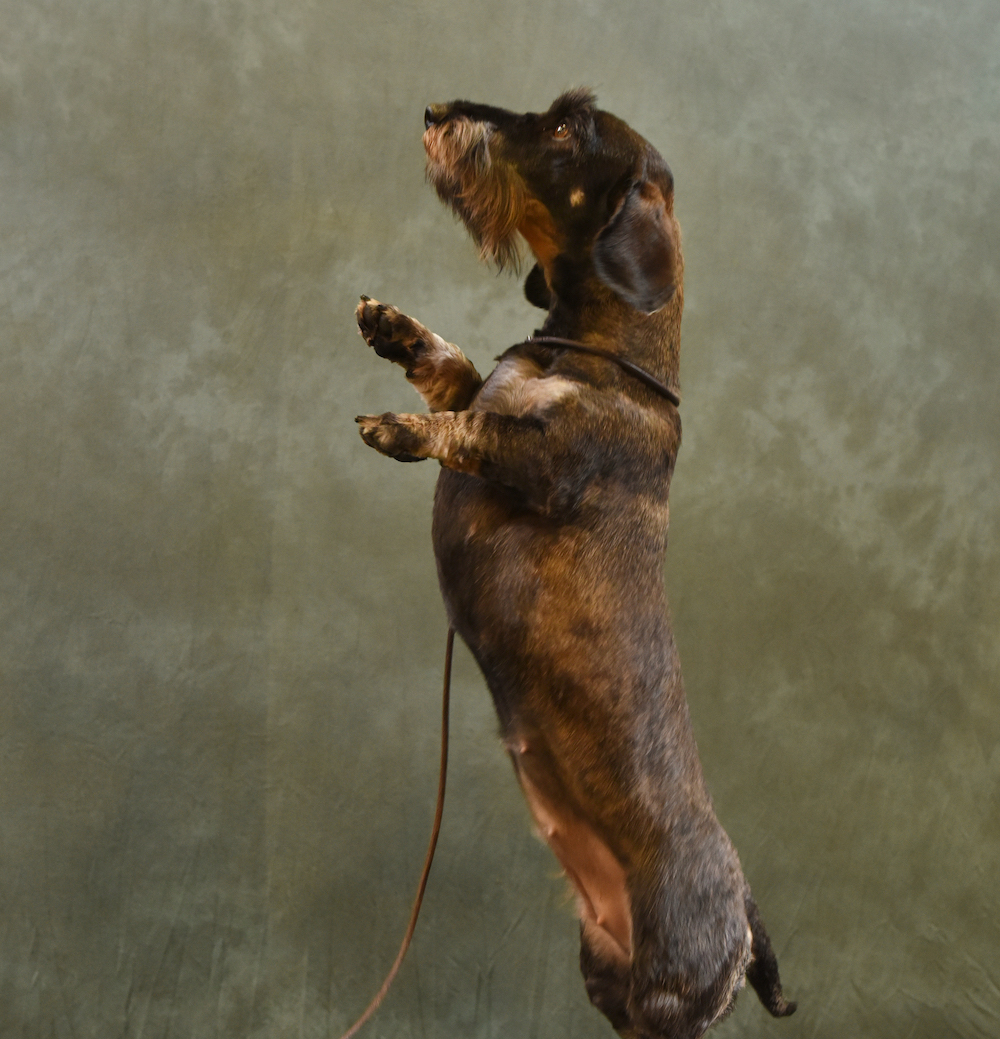
www.dachshund-ivdd.uk - is a fantastic resource for you to learn all about IVDD in dachshunds of all types and is the dedicated IVDD website from Dachshund Health UK. Please take a look as it will impart far more knowledge than I ever could.
IVDD is much more likely to affect dachshunds than other breeds (as many as 1 in 4 might suffer to some degree in their lifetime) There are 3 types of IVDD – our breed, The Dachshund, suffers from Hansen Type 1, where the inner part of the degenerated (calcified) disk herniates, impinging on the spinal cord. There are also many variations in the severity of IVDD suffered, some dogs might just need some rest, a little physiotherapy and some pain relief. Others may need extensive treatment, surgery and rehabilitation. Some dogs will make a full recovery, sadly others will not; and everything in-between.
In other (fabulous) news….STANDARD Wire Haired Dachshunds are statistically the least likely of the 6 varieties in the UK to suffer from IVDD.
Genetics & IVDD
People think IVDD is a symptom of dachshunds having long backs – BUT – They don’t have long backs…. THEY HAVE SHORT LEGS!! And this is really important to remember!
It is understood that the genetics of dwarfism of the limbs (chondroplasia) contributes to IVDD. But that’s only part of the picture… there a now a lot of studies into the genetics of IVDD and many are ongoing, with more certain to follow. Currently there are no known conclusive genetic ‘tests’ we can do for IVDD but we can X ray our dogs to check for calcifications and make the results available for studies. We can also get involved in genetic studies by taking DNA samples from X-rayed dogs for ongoing research.
Bramalodge are open to participating in any studies to try and help improve the health and well-being of dachshunds in the future. We will be submitting genetic swabs of all our back scored dogs to The University Of Cambridge in 2025 for their research into the genetic elements of IVDD.
Breeding & IVDD

As breeders, sadly, getting X ray images of our dog’s backs, and only breeding from ones with low back scores (few calcifications) doesn’t rule out the possibility of IVDD. A dog with zero calcifications can still get IVDD and one with many calcifications may never suffer.
BUT, it is becoming clear now from the studies, that breeding from dogs that have low numbers of calcifications does, bit by bit, reduce the prevalence of the problem.
Moving forward, it is our responsibility to, in my opinion, make every effort to X ray our breeding dogs and pair low scores with low scores where possible. While also considering other factors of health, welfare and maintaining the desired characteristics of the breed.
Lifestyle, Environment & IVDD

What about other factors? Like how we keep our dachshunds and what we do with them/allow them to do?
Dachshunds are a working, active breed and as such they are full of life and like to be busy and into everything. You cannot (and should not) try to ‘over-protect’ your dachshund from ‘LIFE’ - but, you need to recognise the risks of IVDD and be sensible, acting accordingly in the management of your hound..
Here are a few notes about looking after your Sausage….that might help the fight to reduce the risk of IVDD (and other health problems too!)
First & Foremost - FIT not FAT!
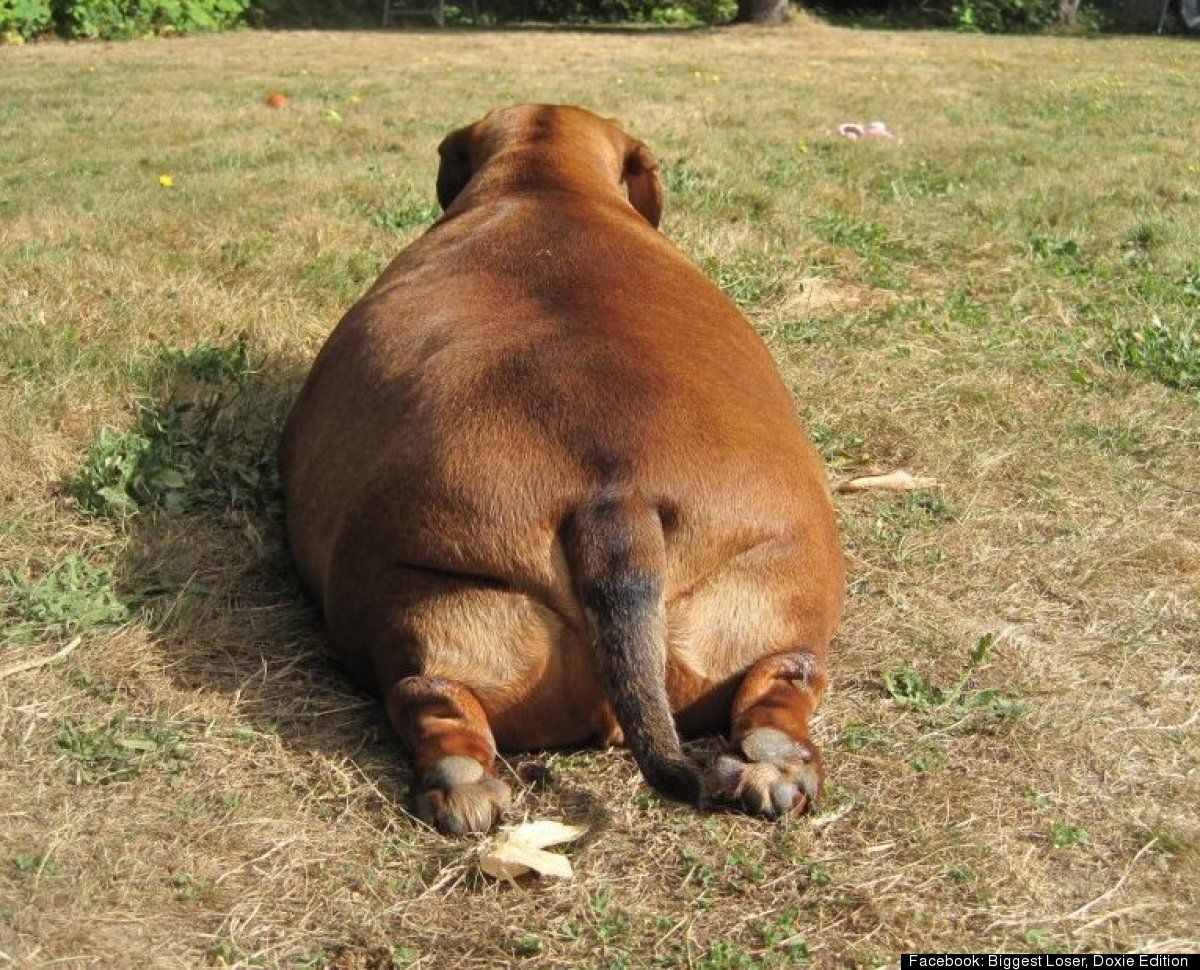
A mantra that we should employ for ourselves….I know I need to cut out the snacks and head to the gym….BUT, even if we can’t cut out the cake, we SHOULD NOT be saying “one for me, one for my sausage”
A FAT UNFIT DACHSHUND IS A VERY, VERY BAD THING….not least for the variety of health conditions being overweight causes for anyone and everyone: Diabetes, joint problems, digestive issues, heart problems…. etc etc
But, the extra weight on that big belly hanging down under that long back…. ??
Anyway, moving on…
-
A mature Dachshund that is well-muscled with an ideal body condition should be capable of all the normal activities of day-to-day living
-
Dachshunds should have a combination of on and off-lead exercise at all ages.
-
All Dachshunds should be active and well-exercised - Increasing/decreasing exercise by age.
-
Don’t over-exercise a puppy; gradually build its amount of exercise until it is 12 months old and its bones and muscles are fully developed. Don’t UNDER-exercise a puppy either!
-
Ideally, dachshunds over 12 months need a daily exercise regime combining “on-lead” walking and free-running/playing. Training and mental stimulation is really important too… tiring the brain will also tire the body and make ‘organising’ your sausage and its routine, far easier!
-
Elderly Dachshunds will need less exercise than when they were younger, but they still should do as much as they comfortably can. Being sedentary isn’t good for them and more than it is us!
-
Feed a well-balanced diet, the very best you can afford, appropriate to your Dachshund’s life-stage
-
Learn about body Condition Scoring or ask your veterinarian
-
Learn to adapt the amount of exercise and food your Dachshund gets to keep it at an ideal Body Condition Score (eg. Going on a walking holiday? Your dachshund is likely to need more calories just like you will! - a week on the sofa because you’re unwell and your long friend is ‘looking after you’ and not getting out so much….reduce the snacks!)
-
FYI Don’t forget treats are calories too… sadly in just the same way Magnums aren’t our favourite calorie free treat… neither are gravy bones, tripe sticks or duck necks theirs! - recognise the difference in calories between a cake and a carrot stick!
-
Allow your Dachshund to mature fully (ideally 2 years old) before considering neutering (unless there is a overruling health reason to do this before) - there is increased evidence that the growth hormones remaining in place for longer have a hugely positive impact on physical and mental health and development in dogs. If we take a moment to equate castration or hysterectomy in humans to the same in dogs…. I’ll leave that there.
-
Sudden shocks (caused by jumping down from on high in particular) will put extra stresses on any dog’s spine, this is more important in Dachsies. Jumping is still something our slinky mates should be allowed to do though. They need to be strengthened and capable. But repeatedly throwing themselves of high chairs, tables and down steep flights of stairs is not so great.
-
Recent studies have shown that using stairs and climbing/jumping and strenuous strength and core activity is likely to be beneficial in reducing the risk of IVDD – but fast flat running (like alongside a pushbike) has a negative impact
-
Young puppies (up to 12 months) and elderly dogs (over 7 years) will be at more risk of hurting themselves however we monitor them. But that is the same in any breed!
Bramalodge & Health Testing for Backs
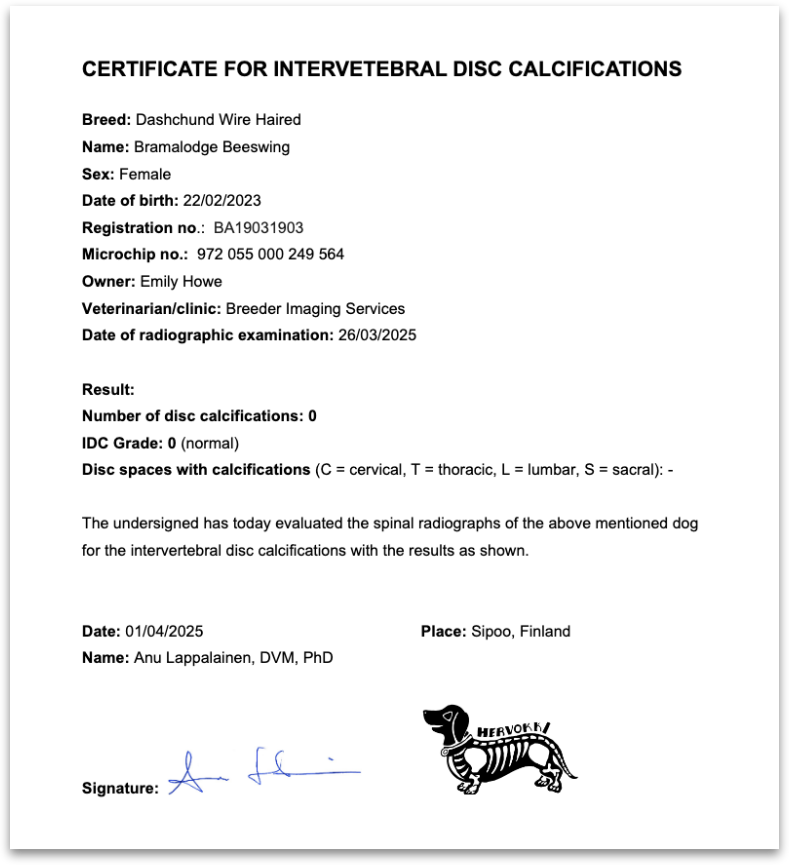
Bramalodge is moving closer to having all the dogs we own back scored (X rayed for calcifications and graded) before breeding. So far, we haven’t had any disappointing scores but they are varied from Grade 0 to Grade 2. I am happy to discuss all our health testing and results with anyone interested and show all the supporting documentation.
Unfortunately, due to covid restrictions and some difficult family challenges not everyone here was able to be X-Rayed and scored in the required 24-48 month age bracket needed for subsidies and statistically admissible results. Moving forward from 2025 this will be the plan.

Another thing which must be considered when finding ourselves focusing on back scoring in breeding dachshunds, is the extremely poor availability of health tested WHD Stud dogs. The UK Kennel Club has now brought out the guidelines of ‘Good Practice’ and ‘Best Practice’ in health testing for all breeds. The STD WHD is no different, but sadly there is still a very small uptake in breeders screening their stud dogs (dogs in general) and publicising the results. This makes it exceptionally challenging to find a fully health tested outside male to use on my health tested girls.
It should also be born in mind that there is more to breeding a healthy litter of puppies than just the back scores of their parents. Consideration of many other factors is equally important. Temperament, type and condition, other conformational factors, other health tests, coat type and a little bit of colour and aesthetics! Oh and of course breeding coefficient… Its not an easy task. Again, as with all things we will happily discuss with anyone how we make our decisions when breeding a litter and with who we breed.
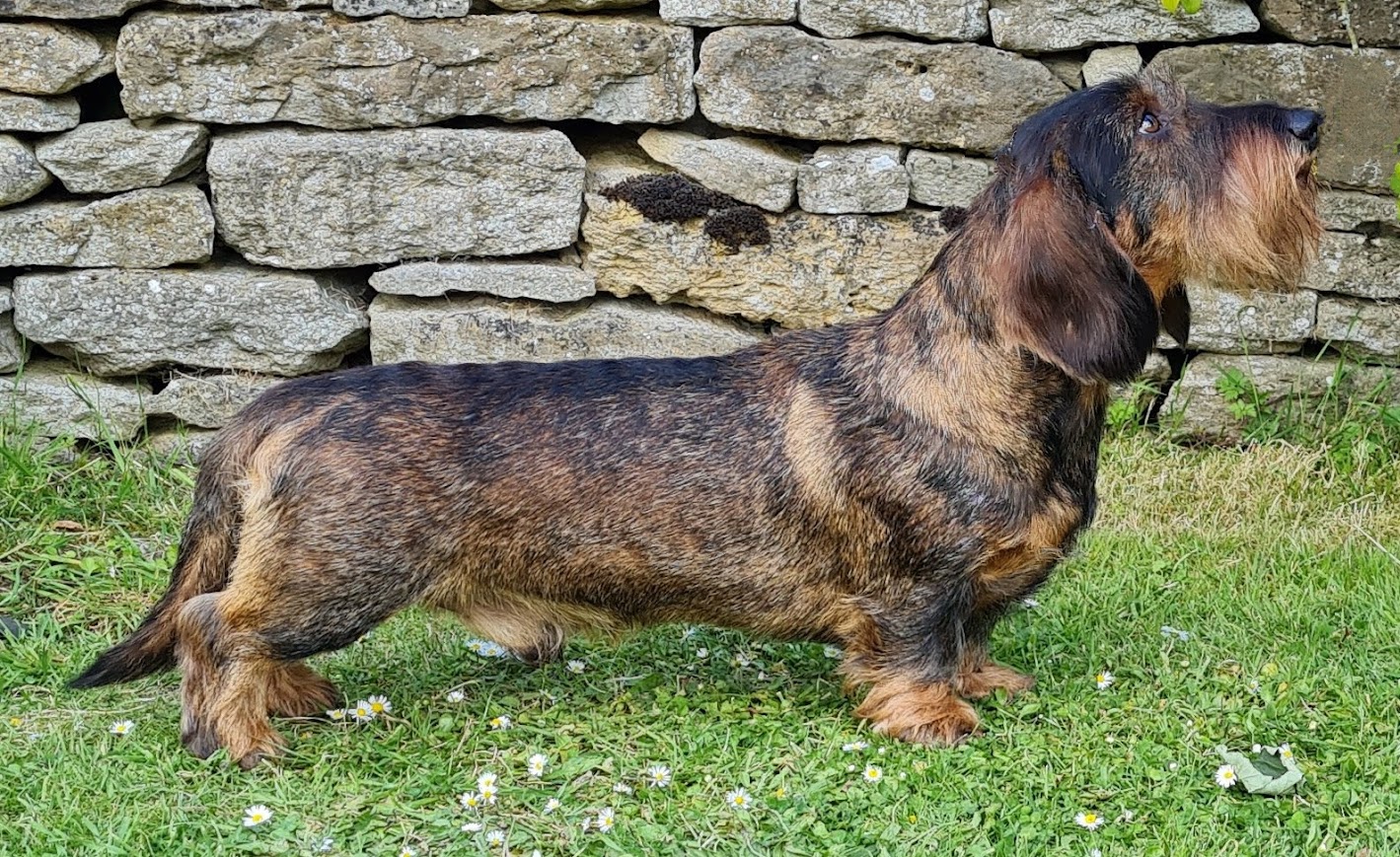
CHAMPION Sunsong Dare to Dream (Spruce). Bred and owned by Sue and Ian Seath of Sunsong Dachshunds. Spruce is a very nice example of the breed and is one of very few Fully Health Tested Wire Haired Dachshund stud dogs in the UK. Hopefully before too long we will see an increase in the numbers of people health testing their dogs. I am delighted to have been able to use Spruce in the past, as well as other stud dogs from Sunsong and hope to do so again in the future. I am very grateful to Sue and Ian for their support over the years and to be able to count them as friends. It is so good to see such well respected and knowledgeable owners and breeders supporting the movement to improve the health of our breed.
So, what else?
Hearts & Heart Problems
So, we don’t need to worry too much about the standard wire haired dachshund heart… other than knowing it is big and bold and full of love and loyalty….
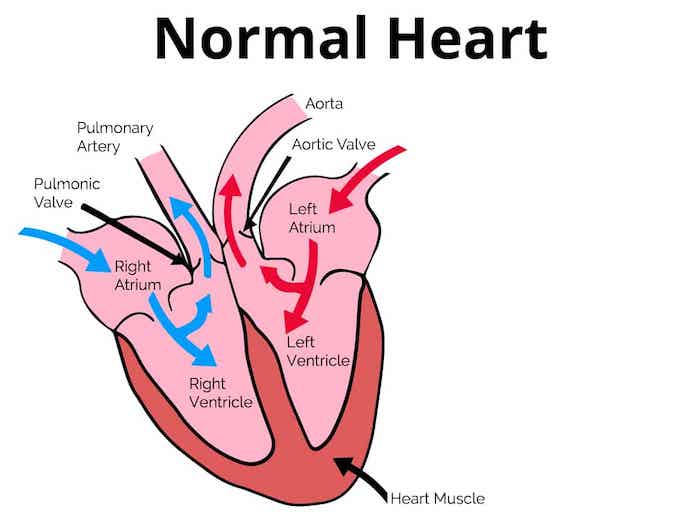
But there is increasing thought given to monitoring the heart in our breed. Thanks to The British Heart Foundation and The PDSA for their descriptions of the conditions.
We should consider, but not be afraid of:
Heart murmurs - A heart murmur is an extra, unusual sound in the heartbeat.
Most heart murmurs are harmless. But they can be a sign of a problem with the heart. Treatment might be needed to keep the heart healthy.
Dilated cardiomyopathy - DCM is a disease of the heart muscle which enlarges the heart’s main pumping chamber, causing the heart’s muscle wall to stretch and become thin (dilate). This makes it harder for the heart to pump blood out of the heart and around the body.
Mitral Valve Disease - (MVD) is a heart problem caused by a faulty heart valve.
It’s the most common type of heart disease in dogs and is especially prevalent in small breeds such as the Cavalier King Charles Spaniel.
MVD typically causes symptoms such as coughing, breathlessness, and low energy, which can range from mild to serious, depending how severely the valve is affected.
Mitral valve disease can’t be cured, but fortunately, most dogs can be well managed with medication and lifestyle changes.
At BRAMALODGE we have taken the decision to have all our dog’s hearts checked with Vicky Ironside Veterinary Cardiologist (MA VetMB CertVC MRCVS)
We are delighted that no issues were found.
Vicky recommended we have the hearts listened too again to monitor the dogs moving forward, as conditions, particularly MVD, can develop as a dog age’s. The younger ones will go back in the age range of 4-5 and the older ones every couple of years.
Eyes & Sight
So… boring boring! Again, there are no concerns about genetically inherited eye diseases or eye issues with Standard WHD’s… But this stuff is good to know…right? AND the UK Kennel Club has announced in its new health testing guidelines, that BVA Eye Testing of STD WHD’s should be considered best practice.
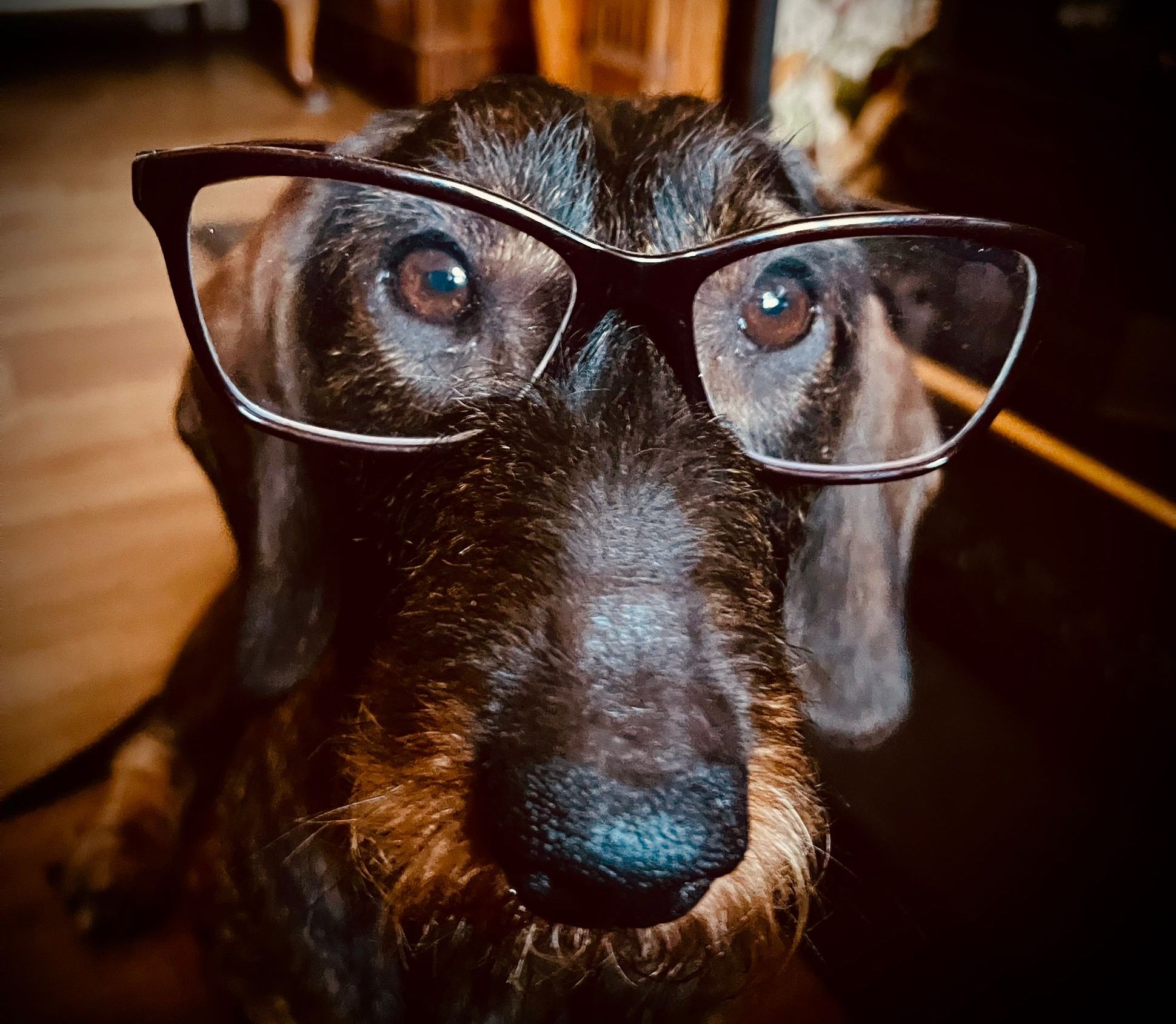
There are lots of things that all types and breeds of dog can have go wrong with their eyes, just like us.
The big one we get asked about is PRA – this is a congenital problem (genetically present from birth) and is hereditary (passed on from parents) eye condition that causes progressing blindness due to degeneration of the light detection cells in the retina of the eye (Genetic Eye Diseases in Dachshunds - Veterinary Vision Center)
The good news for Standard Wire people is it doesn’t affect us! It’s only in the miniature breeds of dachshund.
Bramalodge decided to start BVA eye testing ahead of the UKKC announcement as another responsible health monitoring measure.
We went and saw Vet Paul McPherson who is part of the BVA eye testing scheme , with all the dogs. It was very interesting to watch… but there was very little of note in his findings. None of our dogs have any concerning issues with their eyes and no genetic conditions they could pass on – great news indeed.
We’ll be heading back to see Paul routinely with the younger ones when they reach 12 months and with the breeding dogs every year.
At the moment, eye testing is still not compulsory for our breed. If we are not breeding a dog, I will likely only test eyes every 2 years, unless a condition is found that requires monitoring.
Contact us
Please call me today on 07496 106 745 or use our contact form if you are interested in finding out more about us, our dogs and potential litters.
I love to speak to people and we welcome emails and messages. Visitors are welcome by arrangement.